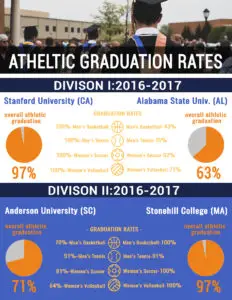What you need to know about NCAA Graduation Rates
Are you planning to use athletic scholarships to pay for your child’s college education? Take a look at the graduation rates for the programs you are considering and use that knowledge to help you form realistic expectations for the athletic scholarships they are offered.
The NCAA measures graduation success rates by the number of athletes who graduate from the school within six years of entering, or 150% of the normal time to completion. The rates vary drastically by sport and coach and range from 100% to 50% or even lower.
Did you notice the NCAA’s figures allow SIX years for athletes to complete their degree program? Honestly, I’ve never known an athlete who needed six years to graduate, but I’ve seen many athletes who required a fifth year to fulfill their degree requirements. Many athletes need extra semesters to complete their degrees because the time demands of training and competition are like a full-time job. Now remember NCAA eligibility only allows athletes to compete for four years. Pretend your daughter has a full ride scholarship (to understand how rare full ride scholarships are read this post), manages to keep it and competes for all four years, but has one more year of college credit to fulfill before graduation. She will have to pay for the last year of college without an athletic scholarship. Even 100% graduation rates are not all good news.
Let’s take a look at the numbers from a couple Division I and II sample schools. We chose 2016-17 as the graduation year so these statistics represent athletes who entered college in 2010 and graduated anytime between 2014 and 2017.

Student Right to Know Act
Why are these numbers available to us? Schools with 100% graduation rates will obviously want to publish that information. But what about an institution like Alabama State University that graduates only 63% of their athletes? Wouldn’t they want to hide numbers like that? They would, that’s why the United States Congress passed the Student Right to Know Act.
The Student Right to Know Act was passed in 1990. All schools receiving Title IV aid, which is federal aid, are required to report the graduation rate of degree seeking full-time students. The law applies to all students not just student athletes.
The Act also requires schools to report “(1) completion or graduation by program or field of study and by individual schools or academic divisions; (2) graduates passing applicable occupational licensure or certification examinations; (3) graduates obtaining employment in occupations for which they trained; and (4) other appropriate institutional outcomes. (5) Crime Awareness and Campus Security (6) student loan default rates.
This law requires all universities and colleges to release this information to every potential student. Here’s how you can access this information:
- Go to the website of any institution and type “student right to know” in the search bar.
- You can see graduation results broken down by gender, ethnicity, Pell Grant recipients, Federal Subsidized Stafford Loan recipients, and more.
- You should also find a page that reports campus safety and security.
- Another page will list licensing pass rates in fields like athletic training, nursing, engineering, or education.
- I had to perform a separate search to find student loan default rates (guess schools want to bury that information!). If you can’t find it on the university website try using The Student Loan Report.
NCAA Graduation Rates
Those numbers can be helpful but they apply to every student enrolled in the school; what about graduation rates for athletes? The NCAA has created its own system for tracking student athlete success. Head over to NCAA.org to find detailed information on how the NCAA tracks the success of athletes receiving athletic aid. In Division I this is called the Graduation Success Rate (GSR). In Division II this is referred to as the Academic Success Rate (ASR). Division III does not award athletic aid, and is encouraged but not required to report their results to the NCAA.
The NCAA uses different metrics to calculate the GSR and ASR than the Federal Government. For example, the federal rate only counts first time, full-time students who enter college in the fall and receive athletic aid for any period of time. However, between 30 and 40% of students will transfer at some point in their degree process, and transferring alone does not indicate that they have not graduated from college. The GSR and ASR begin with the federal data then add data for students who transfer into or out of the institution, mid-year enrollees, and some non-scholarship athletes. These changes make the GSR and ASR numbers a far more reliable measure than the Federal Graduation Rate.
Even better, the NCAA also tracks graduation rates in each sport, at each school. In just a few minutes you can get a fairly reliable graduation rate for every program that is recruiting you. Head over to NCAA.org and find the databases for each division on the right-hand side of the page.
Understanding Athletic Graduation Rates
Here are a few things to keep in mind as you read the numbers:
*Remember these percentages allow athletes to complete their degrees in six years. These numbers cannot tell you how likely your child is to complete their degree in four. When you search for 2016-2017 graduation rates the “Cohort year” will be 2010. That’s the year the class, or cohort, entered college.
*The NCAA lists both the GSR/ASR and the Federal Graduation Rate (FGR). These are calculated differently and do not directly correspond with each other.
*These numbers do not reflect coaching changes. Every coach has different strengths, weaknesses, and emphases. If a coach has only been at a school for one year, you are looking at the graduation rates for the previous coach. If a new coach tells you she places a strong emphasis on academic success, there will be no data to back that up. Instead you will have to ask her about changes she has implemented and how she thinks those will improve graduation rates.
*The college or university as a whole is also responsible for the athletes’ graduation rates. Many provide athletes with academic and tutoring resources they need to be successful. Ideally, the school you choose will intentionally invest in the academic success of every athlete. This is a great question to ask on a campus visit.
*If you look at the graduation rate for only one year in only one sport, the raw number of athletes may be very small. If three athletes enter and one drops out, the graduation rate will be 66%. But it was really only one person. Keep these numbers in perspective.
Here’s How You Can Take Action
- Open up your recruiting binder, file, or computer document with all your recruiting information in it. This might include net price calculations, records of coaches you have called, or here are a few more ideas:
- Go to the website of each college you are considering. Type “student right to know in the search box. Check the campus security statistics, licensing exam pass rates (if applicable to your major), and student loan default rates. Jot down all these numbers. You may think you will remember them all but over time, the numbers start to blur.
- Next search the Division I or Division II success rates. I recommend you check the graduation rate of “all athletes” and athletes in your sport for the last two years. Jot down the numbers.
- Finally, do any of these statistics raise a question in your mind? Write down your question so you’ll be ready to ask the coach on a campus visit or phone call.
This will only take you a few minutes but give you a good understanding of what kind of school is recruiting you. When our son was looking at colleges last year, one school had excellent scholarship opportunities available. But when we looked up their student transfer rate it was approaching 50%. Almost half of all freshmen who entered transferred out of the school before graduation; almost half of the students were so unhappy they wanted to leave. In spite of the scholarships, we crossed that university off our list. We want our kids to enjoy their college experience!
Every school should be invested in the whole person and help their athletes succeed in all of life. There’s no need to write off a school that is just a little lower than others. If you have a reason to love it, you may do very well there. If a coach calls from a school with great graduation rates, maybe you’ll consider it for the first time. The numbers alone cannot make your decision for you, but they can help you make a well-informed decision.
Here is another great article about scholarships: Are You Sure You Are Really Being Recruited?
If you want to be a college athlete…
If you are frustrated because coaches are not calling you…
 If you are ready to get coaches to notice you…
If you are ready to get coaches to notice you…
Then the How to Get Recruited Guide will give you a step-by-step plan to turn your talent into offers. There’s a lot to learn about the recruiting process. How to Get Recruited condenses mountains of advice, and converts it to simple action steps that will get college coaches calling.
How to Get Recruited: Got Talent. Get a Plan. Get Recruited.
LIKE WHAT YOU READ?
Please take a moment to help out your friends and teammates, by clicking on the “sharing is caring” buttons below.
Thanks,
Bryan
P.S. Come join our Facebook group, The Recruiting Code. This is the place to be for parents and coaches to talk about college recruiting. Come learn from each other, share stories and get information that will help your child become a college athlete.


